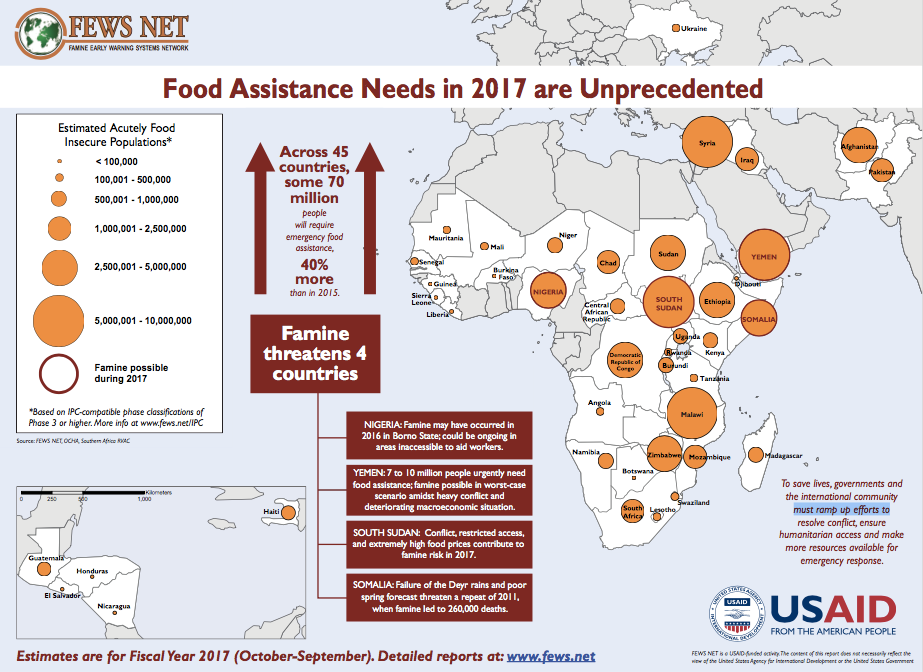
This post was first published on the Africa South of the Sahara Food Security Portal
Despite months of warning , famine continues to threaten large numbers of people in South Sudan, Nigeria, Somalia, and Yemen. Calling the situation “the largest humanitarian crisis since the creation of the United Nations” , the UN estimates that as many as 20 million people are at risk of starvation in these four countries, while millions more across the Horn of Africa (especially Kenya and Ethiopia) face significant food insecurity. The UN estimates that US$5.6 billion will be needed in 2017 and has prepared humanitarian response plans and pooled funds to direct contributions.
Somalia, in particular, is facing its second famine since 2011; research has shown that incentives for early responses must accompany early warning systems in order to avoid subsequent famines. Apart from the significant immediate loss of life, the famine could have long-term consequences for development. According to a quote in Aljazeera by Stephen O’Brien, UN Humanitarian Chief, “children will be stunted by severe malnutrition and will not be able to go to school, gains in economic development will be reversed and livelihoods, futures and hope will be lost."
In South Sudan, IPC analysis indicates that 42 percent of the population is severely food-insecure; this number is expected to grow to 47 percent by July. In Greater Unity State, famine has been declared in some counties. The latest IPC report for South Sudan highlights that, in addition to ramping up the amount of humanitarian aid going to the country, ensuring humanitarian access to vulnerable populations in the face of continued conflict will be crucial in staving off further famine.
IFPRI recently released an analysis of the drivers behind the situations in each country. Among the drivers of the crisis are drought and continuing conflict (as previously covered on the Food Security Portal for <a href="http://ssa.foodsecurityportal.org/regional-sub-portal-blog-entry/sub-sa… Sudan and Somalia; Nigeria ; and the Horn of Africa as a whole). In an interview with Voice of America , Ephraim Nkonya of IFPRI discussed ways in which policymakers can avoid future acute food crises, including: stable governance, diversified incomes, and women’s empowerment, all of which can increase vulnerable populations’ resilience to shocks such as drought.
FEWS NET notes that the need for emergency food assistance is unprecedented in recent decades; the severity of the situation can be seen below.
Source: http://www.fews.net/sites/default/files/Food_assistance_needs_2017.pdf
Emergency relief efforts to provide food, water, and health care are being carried out in South Sudan by the British Red Cross . The organization is providing aid in Yemen as well and notes that up to 70 percent of the population in that country needs emergency aid. The World Food Programme is also working in South Sudan to provide emergency assistance and warns that the number of people at emergency levels of food insecurity in Yemen has increased 20 percent in the past nine months. WFP is requesting $950 million to support seven million people in Yemen this year.
Broader country-specific plans have been launched by a handful of agencies. For example, FAO has launched its Famine Prevention and Drought Response Plan in Somalia and the Emergency Livelihoods Response Plan in Yemen. The plans combine lifesaving interventions with emergency livelihood support, including cash transfers to help populations meet their immediate food and water needs and livelihood support to restore food and livestock production. FAO estimates that USD 160 million will be needed to implement its Famine Prevention and Drought Response Plan in Somalia. In addition, the organization is calling for USD 61 million to implement livelihood support, increase seed production, and strengthen food security information and coordination in South Sudan .
The World Bank is also working with various UN agencies to scale up crisis response in the affected countries. Taking a two-pronged approach that focuses on both immediate relief and long-term resilience and institution building, the Bank is calling for stronger, coordinated efforts among NGOs and policymakers to improve information-gathering, planning, and humanitarian aid investments. Prioritized efforts should include emergency food assistance for the most hard-hit populations and strengthening of social safety nets.
By: Summer Allen and Sara Gustafson, IFPRI
Files:

